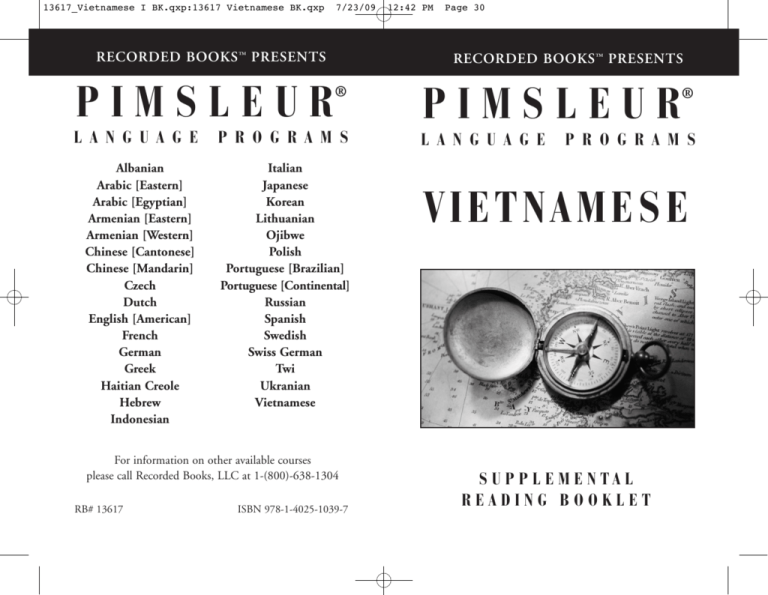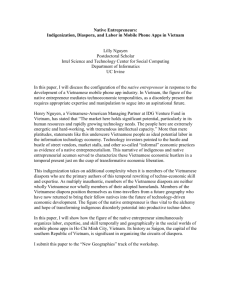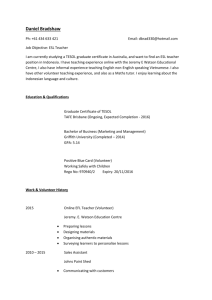
13617_Vietnamese I BK.qxp:13617 Vietnamese BK.qxp
7/23/09
RECORDED BOOKS ™ PRESENTS
PIMSLEUR
Page 30
RECORDED BOOKS ™ PRESENTS
®
L A N G U A G E
P R O G R A M S
Albanian
Arabic [Eastern]
Arabic [Egyptian]
Armenian [Eastern]
Armenian [Western]
Chinese [Cantonese]
Chinese [Mandarin]
Czech
Dutch
English [American]
French
German
Greek
Haitian Creole
Hebrew
Indonesian
Italian
Japanese
Korean
Lithuanian
Ojibwe
Polish
Portuguese [Brazilian]
Portuguese [Continental]
Russian
Spanish
Swedish
Swiss German
Twi
Ukranian
Vietnamese
For information on other available courses
please call Recorded Books, LLC at 1-(800)-638-1304
RB# 13617
12:42 PM
ISBN 978-1-4025-1039-7
PIMSLEUR
L A N G U A G E
®
P R O G R A M S
VIETNAMESE
SUPPLEMENTAL
READING BOOKLET
13617_Vietnamese I BK.qxp:13617 Vietnamese BK.qxp
7/23/09
12:42 PM
Page 2
For immediate, authorized
PIMSLEUR LANGUAGE PROGRAMS
CUSTOMER SERVICE,
please call Recorded Books, LLC
1-800-638-1304.
U.S. and Canada: call direct.
Outside U.S. & Canada: call your local AT&T
Access operator for the phone number
13617_Vietnamese I BK.qxp:13617 Vietnamese BK.qxp
7/23/09
ACKNOWLEDGMENTS
VIETNAMESE
12:42 PM
Page 8
TABLE OF CONTENTS
Introduction to Vietnamese . . . . . . . . . . . . . . . . . 2
Written Vietnamese . . . . . . . . . . . . . . . . . . . . . . . 4
VOICES
English-Speaking Instructor . . . . . . . . . . Jordan Weinstein
Female Vietnamese Speaker . . . . . . . . . . . Nguy en Thi Nha
Male Vietnamese Speaker . . . . . . . . . . . . . Dr. Binh N. Ngo
COURSE WRITER
Dr. Binh N. Ngo
EDITORS
Christopher J. Gainty ♦ Beverly D. Heinle
Cover image ©PhotoDisc, Inc.
All rights reserved
© and ‰ Recorded Program 1995, 1999
by Simon & Schuster Audio, a division of Simon & Schuster, Inc.
© Reading Booklet 1995, 1999
by Simon & Schuster Audio, a division of Simon & Schuster, Inc.
All rights reserved.
Linguistic Notes . . . . . . . . . . . . . . . . . . . . . . . . . 6
Acknowledgments . . . . . . . . . . . . . . . . . . . . . . . 8
13617_Vietnamese I BK.qxp:13617 Vietnamese BK.qxp
7/23/09
12:42 PM
Page 2
7
2
Vietnamese
Vietnamese
Introduction to Vietnamese
Lingusitic Notes (continued)
Vietnamese is the official language of Vietnam.
It is spoken by 70 million people in Vietnam and
approximately two million Vietnamese overseas.
Vietnam is also home to approximately 60 smaller
ethnic groups who speak indigenous languages. Of
these, the largest group is the ethnic Chinese,
speaking both Cantonese and Mandarin Chinese.
Many Vietnamese speak Russian and / or English,
and some older Vietnamese speak French.
However, the majority of social, political, and
cultural communication in Vietnam is conducted in
the Vietnamese language.
Most words in Vietnamese are monosyllabic
(consisting of one syllable) or disyllabic. The
number of polysyllabic words is rather small. In
addition to the words of Mon-Khmer origin, the
Vietnamese vocabulary contains a large number of
words and parts of words borrowed from Chinese.
It makes use, as well, of words of French and
English origin.
Vietnamese belongs to the subfamily of MonKhmer languages in the Austroasiatic language
family. The Austroasiatic family has approximately
150 languages and 80 million speakers in two
important subfamilies, Munda and Mon-Khmer.
The ten Munda languages are spoken by six million
people in northeastern India, and the Mon-Khmer
languages, of which Vietnamese is one, are spoken
throughout much of Southeast Asia. There are
roughly 140 Mon-Khmer languages, but only
Vietnamese and Khmer, or Cambodian (7 million
speakers), are widely-spoken and well-known.
The Vietnamese phonetic system contains twenty-three “initial consonant” sounds. These are b, ph
[f], v, m, t, { [d], th, x [s], d [z], n, 1, tr [t∫], s [∫],
[3], ch, nh, [k], g, kh, ng, h, p, and r. However, in
the Hanoi dialect, the three consonants [t∫], [∫], and
[3] do not exist. The consonants “p” and “r” occur
only in words borrowed from European languages.
The Vietnamese language has eleven “nuclei
monophthong vowels”: i, ê, e, ı, Í, …, a, √, u, ‰, o,
and three “nuclei diphthongs”: i‘ / ia; ıÍ / ıa; and
u‰ / ua.
There are six “final consonants”: p, t, c / ch, m, n,
ng / nh, and two “final semivowels”: i / y and o / u.
13617_Vietnamese I BK.qxp:13617 Vietnamese BK.qxp
7/23/09
12:42 PM
Page 6
6
3
Vietnamese
Vietnamese
Linguistic Notes
Introduction to Vietnamese (continued)
Vietnamese belongs to the group of isolating
languages, where there are no inflectional endings
and all the words are invariable. Grammatical relationships are expressed by the use of auxiliary words
and word order, not by changing the internal structure of the words (the use of inflectional endings).
The Vietnamese language has three main
dialects: northern, central, and southern. The southern dialect is spoken in Ho Chi Minh City (Saigon),
the largest city in Vietnam and the most important
South Vietnamese political, economic, and cultural
center. The differences between the dialects lie in
both the vocabulary and the phonetic system.
However, Vietnamese everywhere understand each
other despite these differences and despite the lack
of a “standard” Vietnamese pronunciation.
In the Vietnamese language, the syllable is the
minimal meaningful unit that cannot be divided into
smaller meaningful parts. Each syllable consists of
two mandatory components: a tone and a nuclei
vowel. Three additional optional components may
be present: an initial consonant, a sound indicating
the labialization (rounding of the lips) of the
syllable, and a final consonant or semivowel. The
structure of the Vietnamese syllable can be
presented as follows:
TONE
INITIAL
CONSONANT
LABILIZATION NUCLEI
VOWEL
FINAL
CONSONANT
/ SEMIVOWEL
This Vietnamese course introduces the contemporary Hanoi (“northern”) dialect. Used in the
capital and considered the most cultured in
Vietnam, the Hanoi dialect represents the phonetic
system of the language more fully than do the other
dialects. The Hanoi dialect is the one most often
used in news broadcasts on national Vietnamese
radio and television and in Vietnamese books,
newspapers, and magazines.
13617_Vietnamese I BK.qxp:13617 Vietnamese BK.qxp
7/23/09
12:42 PM
Page 4
5
4
Vietnamese
Vietnamese
Written Vietnamese
Written Vietnamese (continued)
From approximately the 1st century until the
late l9th century, Vietnamese used the Chinese
writing system for official documents of all sorts as
well as for literature and poetry. In Vietnamese, this
system is called ch˘ Hæn or ch˘ Nho.
20th century, quÂc ng˘ has been the official
Vietnamese alphabet.
A writing system known as ch˘ n‰m, based on
Han Chinese writing, was developed by
Vietnamese Buddhist scholar-priests around the
13th century. This system used composite graphs
borrowed from Chinese, in which one component
signaled the pronunciation, while another indicated
the meaning of a word. However, the new writing
system was unpopular because it was often thought
to be too complicated to learn, and for several
centuries the ch˘ n‰m system existed alongside the
standard written Chinese.
The Roman script was introduced by Catholic
missionaries at the beginning of the 17th century as
a part of their efforts to Christianize Vietnam. The
writing system based on the Roman script is called
quÂc ng˘. Unlike the ch˘ Nho and ch˘ n‰m
systems, quÂc ng˘ is structured around the alphabetic principle, with almost every symbol
representing a structurally significant phonetic
entity, or “phoneme.” Since the beginning of the
The Vietnamese alphabet contains twenty-two
Roman characters: a, b, c, d, e, g, h, i, k, l, m, n ,o, p,
q, r, s, t, u, v, x, and y. Diacritic marks are added to
indicate specific sounds, e.g. √, …, ‘, ‰, ı, Í, {.
Diacritic marks are also used to indicate important
tonal differences.
Vietnamese is a tonal language, where changes
in the pitch level of a word signal a change in
meaning. Vietnamese has six different tones: midlevel (a), low-falling (ø), high-rising (æ),
low-falling-rising (¿), high-rising broken (¡), and
low-falling broken (¬). Except for the mid-level
tone, all of the tones are denoted by diacritic marks,
shown here with the letter “a.”

![vietnam[1].](http://s2.studylib.net/store/data/005329784_1-42b2e9fc4f7c73463c31fd4de82c4fa3-300x300.png)


